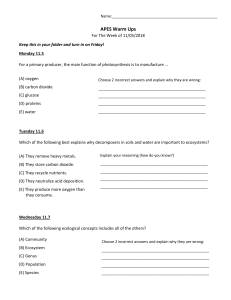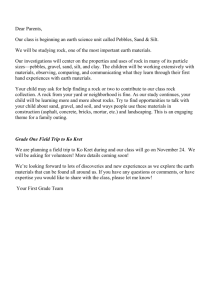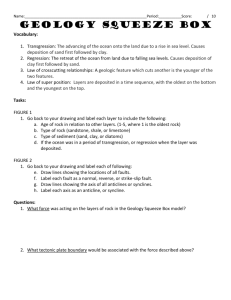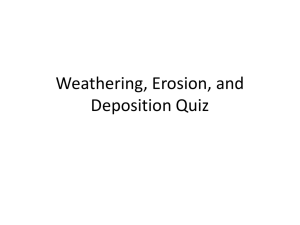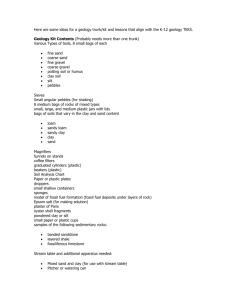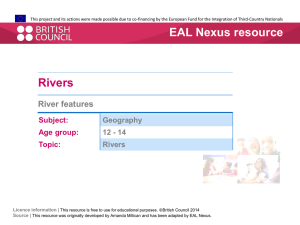studyGuide - christopher1farris
advertisement
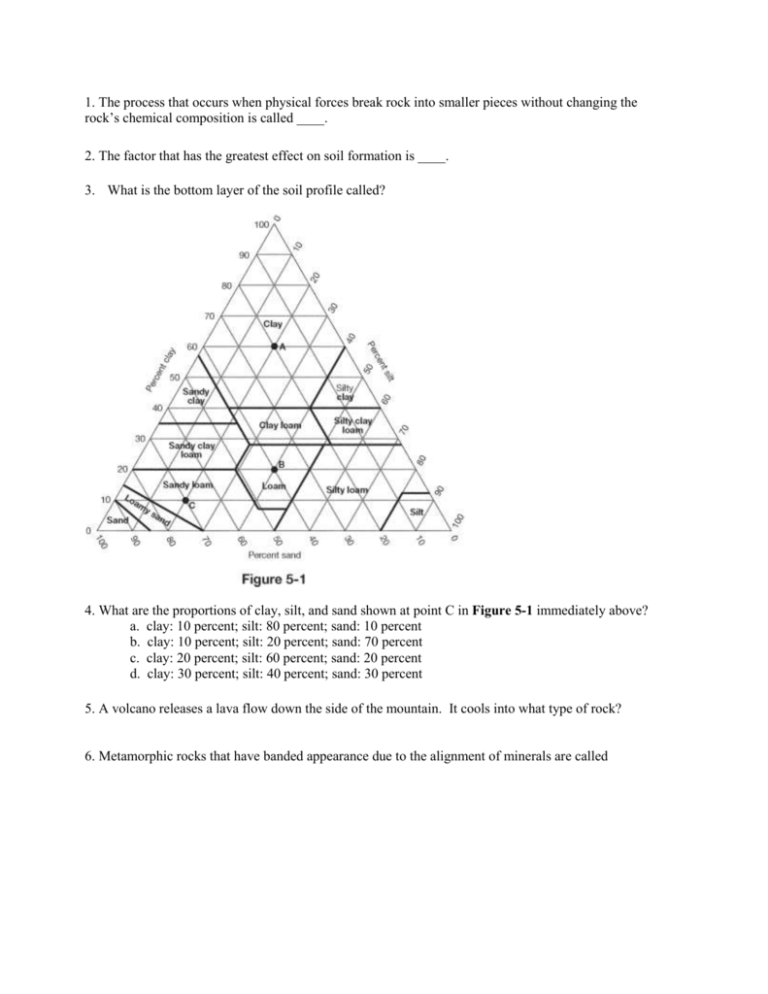
1. The process that occurs when physical forces break rock into smaller pieces without changing the rock’s chemical composition is called ____. 2. The factor that has the greatest effect on soil formation is ____. 3. What is the bottom layer of the soil profile called? 4. What are the proportions of clay, silt, and sand shown at point C in Figure 5-1 immediately above? a. clay: 10 percent; silt: 80 percent; sand: 10 percent b. clay: 10 percent; silt: 20 percent; sand: 70 percent c. clay: 20 percent; silt: 60 percent; sand: 20 percent d. clay: 30 percent; silt: 40 percent; sand: 30 percent 5. A volcano releases a lava flow down the side of the mountain. It cools into what type of rock? 6. Metamorphic rocks that have banded appearance due to the alignment of minerals are called 7. Know the different stages of the rock cycle above. 8. In Figure 3-1 above, what process or processes would be occurring in the part of the rock cycle labeled I ? 9. All of the energy that drives Earth’s rock cycle comes from ____. 10. According to the theory of plate tectonics, ____. 11. What kind of plate boundary occurs where two plates grind past each other without destroying or producing lithosphere? 12. The main difference between a topographic map and a regular map is that: 13. When an earthquake occurs, energy radiates in all directions from its source called the ____. 14. What instrument records earthquake waves? 15. Which layers of Earth make up the lithosphere? 16. What is an earthquake? 17. Look at the diagram of a barycenter. Which labeled line shows where the correct barycenter would be for these two objects? 18. Which of the following space bodies directly affects the motion of nutation? 19. What is the process called when water is changing from the solid state to the gaseous state? 20. Which of the following is NOT one of the sediments that make up soil textures? 21. Which of the following is an example of a renewable resource? 22. What has happened to erosion rates worldwide? a. They have decreased due to human activities. b. They have stayed to same because Mother Nature has kept up with the balance of all things. c. They have increased due to natural processed speeding them up. d. They have increased due to human activities. 23. Which two gases make up the main composition of stars? 24. Because of the Coriolis Effect, ocean currents in the Northern Hemisphere are deflected to the _____. 25. What instrument is used to measure wind speed? 26. What movement of Earth is responsible for night and day? 27. Where must a well reach in the ground in order to consistently draw water from the well? 28. Seasons are caused by _____. 29. What is the term for when Earth’s axis changes to a different direction? A B C D 30. In figure above, what letter labels the zone of saturation? 31. What feature is labeled C in the figure above? 32. The term for the different organisms in the biosphere is___. 33. All of the following are threats to biodiversity EXCEPT a. poisoning bunny rabbits. b. over hunting of tigers. c. accidental forest fires. d. protection of wildlife reserves 34. How does a loss of biodiversity effect the environment? 35. Resources that can be replenished over a relatively short time span are called _____. 36. Which of the following supports the big bang theory? 37. The lines on the weather map that connect points of equal pressure are ______. 38. Which type of pressure system will create most of the precipitation in the United States?” 39. Approximately what percentage of the Earth’s surface do oceans cover? 40. Name the two protective layers that shield us from the harmful radiation of space. a. 41. What is the description of atmospheric conditions over a long period of time? 42. The bottom layer of the atmosphere in which we live in is called the _____. 43. What tool is used to measure the temperature in the air? 44. The ratio of air’s actual water vapor content to the amount of water needed for saturation is the 45. Select the best description for global warming and the greenhouse effect. a. They are both natural events b. The greenhouse effect is manmade and global warming is natural c. The greenhouse effect is natural and global warming is manmade d. They are both manmade 46. What type of cloud will bring thunder and lightning? 47. What happens to the density of water as the temperature decreases? 48. The energy for the water cycle comes from the 49. Which is a biotic factor that affects the size of a population in a specific ecosystem? 50. A ____________________ is a large group of stars, dust, and gases held together by gravity. 51. Why are we trying to find alternate energies to the fossil fuels that we depend on? 52. Fresh water is used for which of the following?



